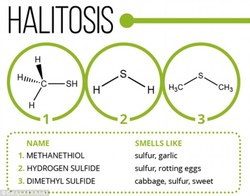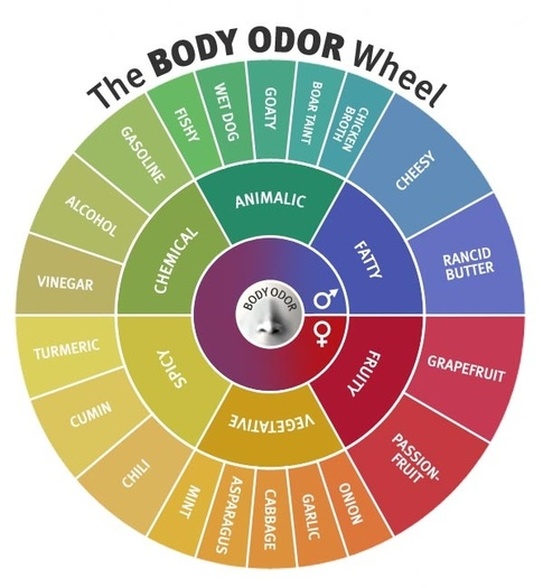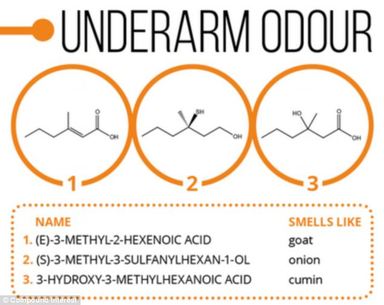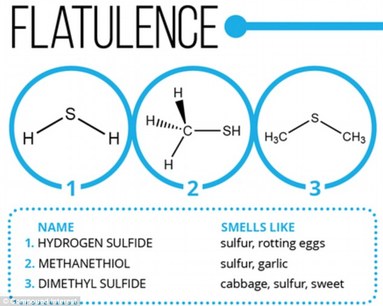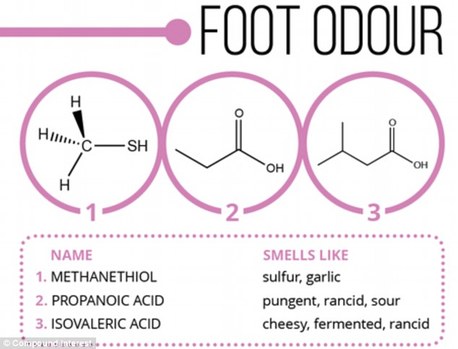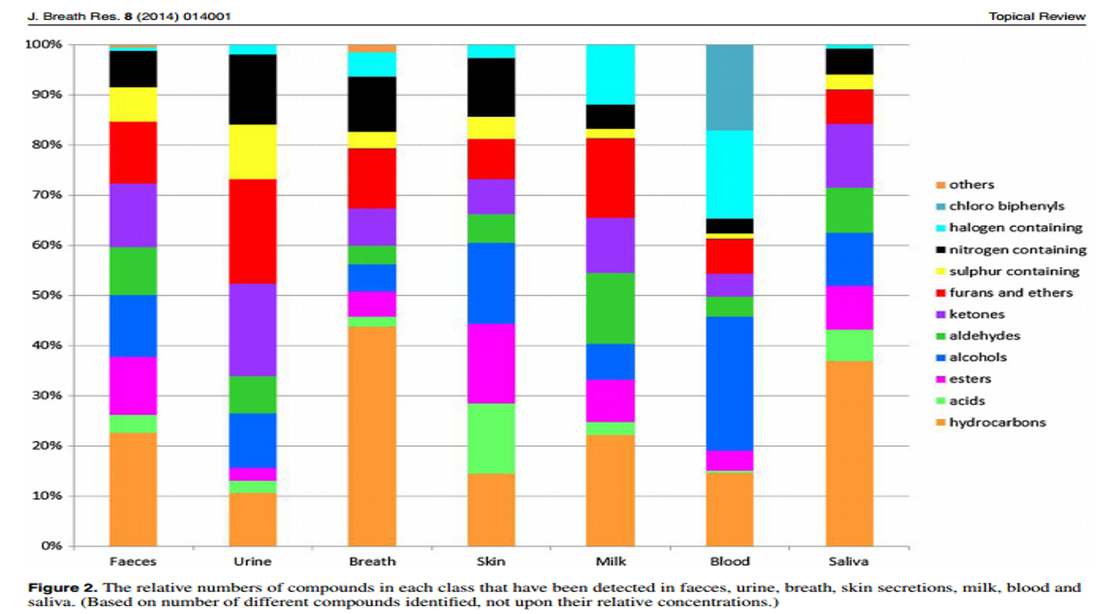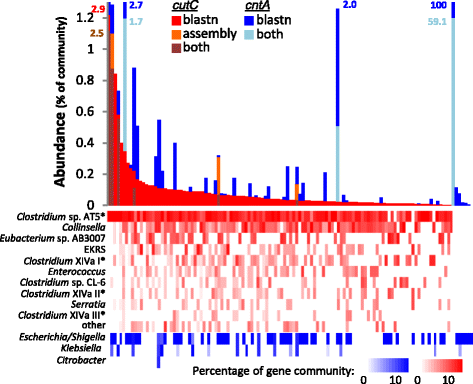See Aurametrix summaries for Acidic smell; Ammoniacal odor; Bad breath; Burning odor, Chemical odor; Fecal odor; Fatty odor; Fishy smell; Musty odor; Old book smell; Body odor; Rancid butter odor; Sweetish odor; Salty odor; Sulfur odor; Vaginal odor; Wet dog odor.
Read blog posts about odors.
Examples of chemicals responsible for smells.
Read blog posts about odors.
Examples of chemicals responsible for smells.
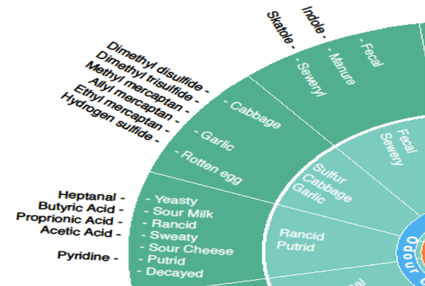
Fecal volatiles have been implicated in IBS, IBD, vomiting, bowel obstruction, and infections Clostridium difficile, Campylobacter, Salmonella and Cholera.
Sulfur volatiles such as methanethiol and hydrogen sulfide are increased in lung and colon cancers. Dimethyl sulfide along with ketone/methyl ketones is increased in breath of liver patients. People perceive the odor as mousy, sweet fecal and fishy.
Gasoline compounds are indicative of heart disease. Fuel chemicals could be also present in Asthma, COPD and Cystic Fibrosis.
Fatty and earthy odors may be associated with aging.
Ammonia-like odor (also described as urine-like or "fishy", owing to secondary and tertiary amines, dimethylamine and trimethylamine) is present in people with kidney diseases.
Infections have characteristic odors too - for example, blue-green-pus infections caused by Pseudomonas could make people smell like grapes and bitter almonds, tuberculosis could cause smell resembling stale beer and yellow fever virus makes the body to smell like a butcher's shop. Body odor of someone infected with C. difficile can appear "swampy", Rotavirus gives sharply sweet putrid smell that some people associate with wet dogs, H. pylori can create a range of foul odors such as fecal, cheesy and ammonia. Read more about odors associated with infections.
Sulfur volatiles such as methanethiol and hydrogen sulfide are increased in lung and colon cancers. Dimethyl sulfide along with ketone/methyl ketones is increased in breath of liver patients. People perceive the odor as mousy, sweet fecal and fishy.
Gasoline compounds are indicative of heart disease. Fuel chemicals could be also present in Asthma, COPD and Cystic Fibrosis.
Fatty and earthy odors may be associated with aging.
Ammonia-like odor (also described as urine-like or "fishy", owing to secondary and tertiary amines, dimethylamine and trimethylamine) is present in people with kidney diseases.
Infections have characteristic odors too - for example, blue-green-pus infections caused by Pseudomonas could make people smell like grapes and bitter almonds, tuberculosis could cause smell resembling stale beer and yellow fever virus makes the body to smell like a butcher's shop. Body odor of someone infected with C. difficile can appear "swampy", Rotavirus gives sharply sweet putrid smell that some people associate with wet dogs, H. pylori can create a range of foul odors such as fecal, cheesy and ammonia. Read more about odors associated with infections.
In ancient times, humans could smell and recognize each other at long distances. Cadet de Gassicourt, in the Dictionnaire (les Sc. Med.), speaks of a young lady who could distinguish men from women simply by their odor. In 1684, the Journal des Savants describes a case of a Hungarian monk who was able to distinguish women from men in the same way. Menstruating females are known to have a characteristic scent emanating from their bodies. Alexander the Great, according to Plutarch, exhaled tlhe perfume of violets when he perspired. Malherbe, Cujas, and Haller are said to have diffused an agreeable odor of musk. But most often, odorprints of ordinary individuals are perceived as sulphurous and unpleasant. French barber surgeon Ambroise Paré observes that this is especially noticeable in the red-haired and freckled. Dark-complexioned persons smell of prussic acid; blonds, much more feebly, of musk. Overweight persons have oily smell. Finns, Eskimos, Jews, and others were judged by European doctors to possess a characteristic unpleasant smell. Asian doctors thought Europeans were the foul ones. Blacks were thought to be at greater risk of shark attack due to their "ammoniacal" odor. The elderly were said to smell like "dry leaves," the lethargic like cadavers, and lunatics "fetid and penetrating." Military sweat resembled "rotten straw" and spoiled vinegar, skin conditions such as eczema or impetigo emmited feebly acid and moldy smell, and acute rheumatism had a penetrating odor.
Although sometimes called “armpit effect”, the ability to distinguish strangers and unfamiliar kins by their scents is not tied to armpit emanations, but depends on the entire body chemistry.
Although sometimes called “armpit effect”, the ability to distinguish strangers and unfamiliar kins by their scents is not tied to armpit emanations, but depends on the entire body chemistry.
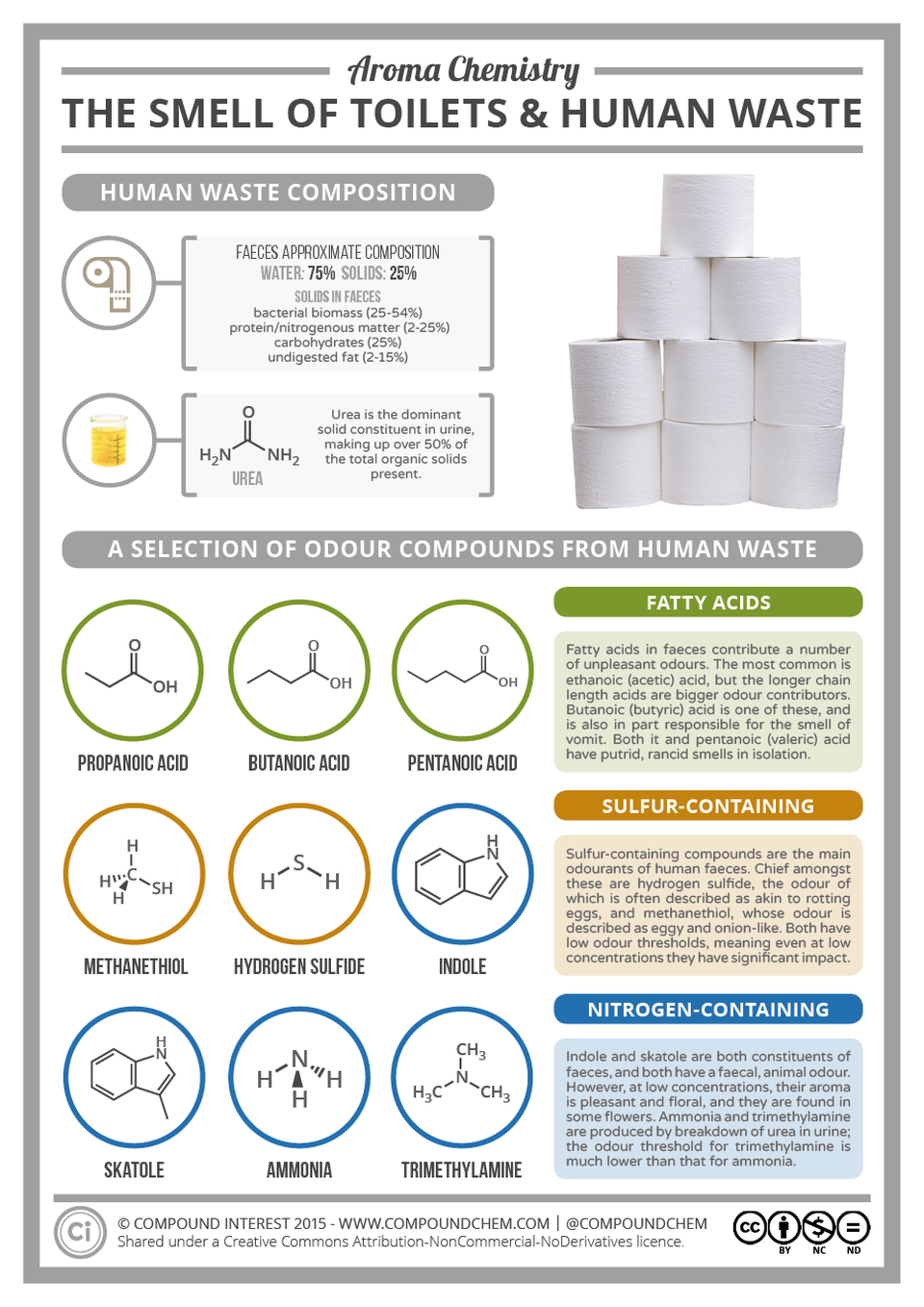
Nine most prominent of the 28 key odorants in used incontinence products are: 3-methylbutanal, trimethylamine, cresol, guaiacol, 4,5-dimethylthiazole-S-oxide, diacetyl, dimethyl trisulfide, 5-methylthio-4-penten-2-ol, and an unidentified compound.
|
TMA-producing genes in metagenomes of fecal samples.
Noncommensal bacteria that produce TMA from various substrates include Actinobacteria - Micrococcus (Carnitine, Choline, TMA N-oxide), Mobiluncus (Carnitine, TMA N-oxide), Olsenella (Choline); Bacteroidetes - Bacteroides (Choline); Firmicutes: Anaerococcus (Choline), Bacillus (TMA N-oxide), Clostridium (Betaine, Choline, TMA N-oxide); Desulfitobacterium (Choline); Eubacterium (Betaine); Sporomusa (Betaine), Staphylococcus (TMA N-oxide), Streptococcus (TMA N-oxide); Proteobacteria - Acinetobacter (Carnitine), Alcaligenes (Ergothioneine, TMA N-oxide), Burkholderia (Ergothioneine), Campylobacter (Ergothioneine), Citrobacter (Carnitine), Desulfovibrio (Choline), Enterobacter (Choline), Enterococcus (Choline), Edwardsiella (Choline), Escherichia coli (Ergothioneine, Carnitine, Choline), Klebsiella (Carnitine, Choline), Proteus (Carnitine, Choline), Providencia (Choline), Pseudomonas (Carnitine, Choline), Stigmatella (Ergothioneine), Stinorhizobium (Ergothioneine), Yokenella (Choline). Fish odor not related to TMAU-like symptoms can be also associated with other microbes such as Aerococcus urinae. |
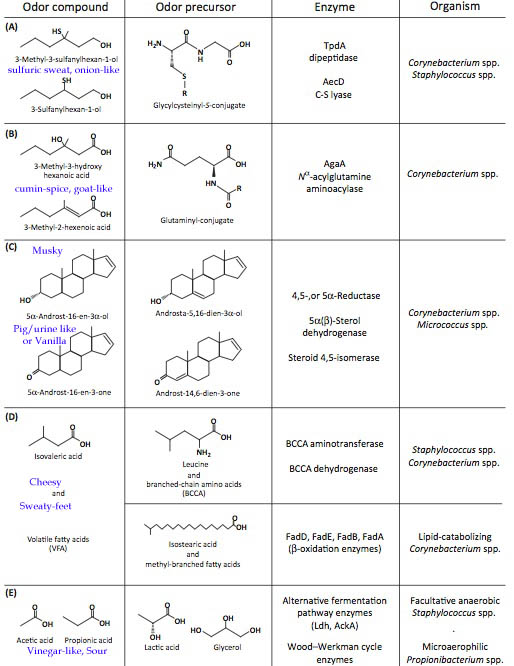
Major chemicals, enzymes and microbes responsible for axillarybody odor Recent studies have revealed the metabolic pathways responsible for bacterial TMA production, primarily the anaerobic glycyl radical-containing, choline-TMA lyase, CutC and the aerobic carnitine monooxygenase, CntA. Bacterial strains confirmed include Citrobacter freundii CntA, Acinetobater baumanii, Escherichia coli CntA and Escherichia coli YeaW.
|
References
- Jameson E, Quareshy M, Chen Y. Methodological considerations for the identification of choline and carnitine-degrading bacteria in the gut. Methods. 2018 Apr 19.
- Rath S, Heidrich B, Pieper DH, Vital M. Uncovering the trimethylamine-producing bacteria of the human gut microbiota. Microbiome. 2017 Dec;5(1):54.
- Qiu L, Tao X, Xiong H, Yu J, Wei H. Lactobacillus plantarum ZDY04 exhibits a strain-specific property of lowering TMAO via the modulation of gut microbiota in mice. Food & function. 2018;9(8):4299-309.
- Zhu Y., Jameson E., Crosatti M., Schäfer H., Rajakumar K., Bugg T.D., Chen Y. Carnitine metabolism to trimethylamine by an unusual Rieske-type oxygenase from human microbiota. Proc. Natl. Acad. Sci. 2014;111(11):4268–4273.
- Ditullio D., Anderson D., Chen C.-S., Sih C.J. L-carnitine via enzyme-catalyzed oxidative kinetic resolution. Bioorg. Med. Chem. 1994;2(6):415–420.
- Kleber H., Seim H., Aurich H., Strack E. Utilization of trimethylammonium-compounds by Acinetobacter calcoaceticus (author's transl) Arch. Microbiol. 1977;112(2):201–206.
- Weimer P.J., Van Kavelaar M.J., Michel C.B., Ng T.K. Effect of phosphate on the corrosion of carbon steel and on the composition of corrosion products in two-stage continuous cultures of Desulfovibrio desulfuricans. Appl. Environ. Microbiol. 1988;54(2):386–396.
- Craciun S., Balskus E.P. Microbial conversion of choline to trimethylamine requires a glycyl radical enzyme. Proc. Natl. Acad. Sci. 2012;109(52):21307–21312.
- Rath S., Heidrich B., Pieper D.H., Vital M. Uncovering the trimethylamine-producing bacteria of the human gut microbiota. Microbiome. 2017;5(1):54.
- Kalnins G., Sevostjanovs E., Hartmane D., Grinberga S., Tars K. CntA oxygenase substrate profile comparison and oxygen dependency of TMA production in Providencia rettgeri. J. Basic Microbiol. 2018;58(1):52–59.
- Koeth R.A., Levison B.S., Culley M.K., Buffa J.A., Wang Z., Gregory J.C., Org E., Wu Y., Li L., Smith J.D., Tang W.H., DiDonato J.A., Lusis A.J., Hazen S.L. gamma-Butyrobetaine is a proatherogenic intermediate in gut microbial metabolism of L-carnitine to TMAO. Cell Metab. 2014;20(5):799–812
- Romano K.A., Martinez-del Campo A., Kasahara K., Chittim C.L., Vivas E.I., Amador-Noguez D., Balskus E.P., Rey F.E. Metabolic, epigenetic, and transgenerational effects of gut bacterial choline consumption. Cell Host Microbe. 2017;22(3) 279-290. e7.
- Martínez-del Campo A., Bodea S., Hamer H.A., Marks J.A., Haiser H.J., Turnbaugh P.J., Balskus E.P. Characterization and detection of a widely distributed gene cluster that predicts anaerobic choline utilization by human gut bacteria. mBio. 2015;6(2) e00042–15.
- Romano K.A., Vivas E.I., Amador-Noguez D., Rey F.E. Intestinal microbiota composition modulates choline bioavailability from diet and accumulation of the Proatherogenic metabolite Trimethylamine-N-Oxide. mBio. 2015;6(2) e02
